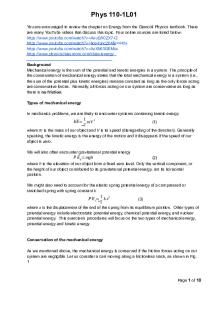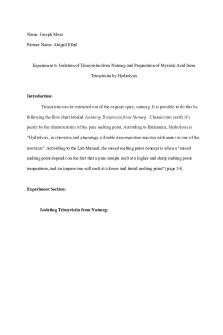Lab 5 Lab Report- (Microbiology) PDF

| Title | Lab 5 Lab Report- (Microbiology) |
|---|---|
| Author | Alexis Talley |
| Course | Microbiology |
| Institution | Arkansas State University |
| Pages | 4 |
| File Size | 362.3 KB |
| File Type | |
| Total Downloads | 61 |
| Total Views | 162 |
Summary
E.coli lab report...
Description
Lab #5: Aseptic Technique and Culturing Microbes Lab Report Name: Alexis Talley Date: October 5th, 2020 Introduction: The purpose of the lab was to follow aseptic technique and safely transfer the microbes in the test tubes to the mini petri dishes. This was completed following HOL protocol and proper laboratory safety techniques.
Materials and Methods: Using aseptic technique, an E. coli pellet was rehydrated in nutrient broth, then incubated for 120 hours at approximately 24 degrees Celsius. The culture was inspected for growth, and then it was subcultured into a Tryptic Soy Agar (TSA) plate with a quadrant streak inoculation and incubated again at 24 degrees Celsius for 48 hours. The plate was then re-inspected for growth and isolated colonies. This process was repeated for S. epidermidis and S. cerevisiae.
Results: The microbes that were cultured grew rapidly in various amounts over time. The tubes all became very cloudy within the 120 hours, but the S. cerevisiae was the least cloudy compared to the other test tubes. On the TSA plates, the E. coli colonies were a creamy oatmeal color. It looked like smeared petroleum jelly. It has a filamentous shape and margin. It also had a raised elevation, and the size remained pinpoint to moderate. The S. epidermidis colonies were smaller and white in color. They had a circular spindle shape. Filamentous margin, flat elevation, and size ranged from pinpoint to moderate. S. cerevisiae yeast cultures were the slowest to start growing. It was a green/ yellowish oatmeal color. It had a irregular and filamentous shape. The margin was entire. Elevation was raised, and size was large.
Figure 1. Culture tubes at Time 0 hours Incubation
Figure 2. Culture tubes at 24 hours incubation
Page 1 of 4
Figure 3: 48 hours
Figure 4: 72 hours
Figure 5: 96 hours
Page 2 of 4
Figure 6: 120
Figure 7: TSA plates at 0 hours incubation. I forgot to record images of the plates at 0 hours. Figure 8: TSA plates at 24 hours incubation.
Figure 9: TSA plates at 48 hours
Page 3 of 4
(This took 48 hours, the other plates had significant growth) Figure 10: 72 hours
(This took 72 hours, the other plates had significant growth)
Table 1. Number of colonies formed (CFU’s) on TSA 50 mm plate over time Incubation E.coli S. epidermidis S. cerevisiae Time (hours) 0 0 0 0 24 12 29 0 48 67 40 0 72 88 63 3 96 110 89 4 Conclusion: The microbes were all successfully inoculated into the TSA plates. Contamination did not occur in any plates or test tubes. Proper aseptic technique was achieved for all of the cultured plates. Discussion: The microbes all grew at varying rates, colors, and shapes. The S. cerevisiae plate had no growth after 48 hours. I had to redo the plate, and I still only got partial growth. I believe this occurred when trying to perform the quadrant smear. I think my inoculating loop had too much alcohol on it, therefore killing my bacteria. This was an error on my part. When I redid the plate, I was very sure to shake all alcohol off before smearing. After 48 hours of being re-done, my plates bacteria flourished. I followed aseptic protocol and transferred all microbes safely using lab safety techniques and following instructions provided by HOL. Page 4 of 4...
Similar Free PDFs

Lab 5 Lab Report- (Microbiology)
- 4 Pages

Yogurt Lab report microbiology
- 1 Pages

Microbiology Lab report
- 15 Pages

Microbiology lab report
- 6 Pages

LAB REPORT OF MICROBIOLOGY
- 7 Pages

LAB 5 - Lab report
- 4 Pages

Lab Report 5 - lab
- 5 Pages

Lab 5 - Lab report
- 6 Pages

Lab 5 - Lab experiment report
- 6 Pages

Phys lab 5 - Lab report
- 10 Pages

Post Lab Report Lab 5
- 5 Pages

Lab Report 5
- 8 Pages

Lab Report 5
- 16 Pages

Lab 5 Report
- 5 Pages
Popular Institutions
- Tinajero National High School - Annex
- Politeknik Caltex Riau
- Yokohama City University
- SGT University
- University of Al-Qadisiyah
- Divine Word College of Vigan
- Techniek College Rotterdam
- Universidade de Santiago
- Universiti Teknologi MARA Cawangan Johor Kampus Pasir Gudang
- Poltekkes Kemenkes Yogyakarta
- Baguio City National High School
- Colegio san marcos
- preparatoria uno
- Centro de Bachillerato Tecnológico Industrial y de Servicios No. 107
- Dalian Maritime University
- Quang Trung Secondary School
- Colegio Tecnológico en Informática
- Corporación Regional de Educación Superior
- Grupo CEDVA
- Dar Al Uloom University
- Centro de Estudios Preuniversitarios de la Universidad Nacional de Ingeniería
- 上智大学
- Aakash International School, Nuna Majara
- San Felipe Neri Catholic School
- Kang Chiao International School - New Taipei City
- Misamis Occidental National High School
- Institución Educativa Escuela Normal Juan Ladrilleros
- Kolehiyo ng Pantukan
- Batanes State College
- Instituto Continental
- Sekolah Menengah Kejuruan Kesehatan Kaltara (Tarakan)
- Colegio de La Inmaculada Concepcion - Cebu

